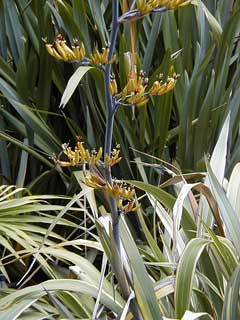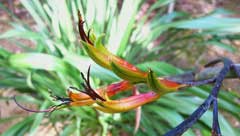 |
|
http://commons.wikimedia.org/wiki/User:Cillas |
 |
| http://commons.wikimedia.org/wiki/User:Avenue |
Translate this page:
Summary
Phormium cookianum Le Jol. is a synonym of Phormium colensoi Hook.f.
Physical Characteristics

 Phormium cookianum is an evergreen Perennial growing to 1.2 m (4ft) by 0.3 m (1ft in).
Phormium cookianum is an evergreen Perennial growing to 1.2 m (4ft) by 0.3 m (1ft in).
See above for USDA hardiness. It is hardy to UK zone 8 and is not frost tender. It is in leaf all year, in flower from July to August. The species is hermaphrodite (has both male and female organs).
Suitable for: light (sandy), medium (loamy) and heavy (clay) soils. Suitable pH: mildly acid, neutral and basic (mildly alkaline) soils. It can grow in semi-shade (light woodland) or no shade. It prefers moist or wet soil. The plant can tolerate maritime exposure.
UK Hardiness Map
US Hardiness Map
Synonyms
P. cookianum. Le Jolis. P. hookeri.
Plant Habitats
Woodland Garden Sunny Edge; Bog Garden; Cultivated Beds;
Edible Uses
Edible Parts: Nectar
Edible Uses: Coffee Gum Gum
The roasted seed is used as a coffee substitute[173]. An edible nectar is obtained from the flowers[173]. An edible gum is obtained from the base of the leaves[173].
References More on Edible Uses
Medicinal Uses
Plants For A Future can not take any responsibility for any adverse effects from the use of plants. Always seek advice from a professional before using a plant medicinally.
None known
References More on Medicinal Uses
The Bookshop: Edible Plant Books
Our Latest books on Perennial Plants For Food Forests and Permaculture Gardens in paperback or digital formats.

Edible Tropical Plants
Food Forest Plants for Hotter Conditions: 250+ Plants For Tropical Food Forests & Permaculture Gardens.
More

Edible Temperate Plants
Plants for Your Food Forest: 500 Plants for Temperate Food Forests & Permaculture Gardens.
More

More Books
PFAF have eight books available in paperback and digital formats. Browse the shop for more information.
Shop Now
Other Uses
Adhesive Fibre Gum Gum
A high quality pliable fibre is obtained from the leaves[153]. A gum found at the base of the leaves is used as a paper glue[173].
Special Uses
Food Forest
References More on Other Uses
Cultivation details
Prefers a rich loamy soil[1] but is not too fussy, succeeding in peaty soils and in boggy moorland[11]. Tolerates light shade[1] but prefers full sun[200]. Plants can be grown in quite coarse grass, which can be cut annually in the autumn[233]. Very tolerant of maritime exposure, this species is recommended for coastal plantings[166, 187]. Hardy to about -10°c[187]. Polymorphic, there are many named varieties[200]. This species often hybridizes with P. tenax and there are many cultivars of uncertain origin. Members of this genus are rarely if ever troubled by browsing deer or rabbits[233].
References Carbon Farming Information and Carbon Sequestration Information
Temperature Converter
Type a value in the Celsius field to convert the value to Fahrenheit:
Fahrenheit:
The PFAF Bookshop
Plants For A Future have a number of books available in paperback and digital form. Book titles include Edible Plants, Edible Perennials, Edible Trees,Edible Shrubs, Woodland Gardening, and Temperate Food Forest Plants. Our new book is Food Forest Plants For Hotter Conditions (Tropical and Sub-Tropical).
Shop Now
Plant Propagation
The seed is best sown as soon as it is ripe in a cold frame. Sow stored seed in February in a cold frame. Germination is sometimes poor but should take place in 1 - 6 months at 15°c. The seedlings are very variable. When they are large enough to handle, prick the seedlings out into individual pots and grow them on in the greenhouse for at least their first winter. Plant them out into their permanent positions in late spring or early summer, after the last expected frosts. The seed remains viable for about 12 months in normal storage[1]. Division in spring as growth commences. Very easy, larger divisions can be planted out direct into their permanent positions. We have found that it is better to pot up the smaller divisions and grow them on in light shade in a cold frame until they are well established before planting them out in late spring or early summer.
Other Names
If available other names are mentioned here
Native Range
AUSTRALASIA: New Zealand (North Island, South Island, Stewart Island)
Weed Potential
Right plant wrong place. We are currently updating this section.
Please note that a plant may be invasive in one area but may not in your area so it's worth checking.
Conservation Status
IUCN Red List of Threatened Plants Status :

Growth: S = slow M = medium F = fast. Soil: L = light (sandy) M = medium H = heavy (clay). pH: A = acid N = neutral B = basic (alkaline). Shade: F = full shade S = semi-shade N = no shade. Moisture: D = dry M = Moist We = wet Wa = water.
Now available:
Food Forest Plants for Mediterranean Conditions
350+ Perennial Plants For Mediterranean and Drier Food Forests and Permaculture Gardens.
[Paperback and eBook]
This is the third in Plants For A Future's series of plant guides for food forests tailored to
specific climate zones. Following volumes on temperate and tropical ecosystems, this book focuses
on species suited to Mediterranean conditions—regions with hot, dry summers and cool, wet winters,
often facing the added challenge of climate change.
Read More
Expert comment
Author
Le Jolis.
Botanical References
1144200
Links / References
For a list of references used on this page please go here
Readers comment
| Add a comment |
|
If you have important information about this plant that may help other users please add a comment or link below. Only comments or links that are felt to be directly relevant to a plant will be included. If you think a comment/link or information contained on this page is inaccurate or misleading we would welcome your feedback at [email protected]. If you have questions about a plant please use the Forum on this website as we do not have the resources to answer questions ourselves.
* Please note: the comments by website users are not necessarily those held by PFAF and may give misleading or inaccurate information.
To leave a comment please Register or login here All comments need to be approved so will not appear immediately.
|
Subject : Phormium cookianum
|
|
|
|